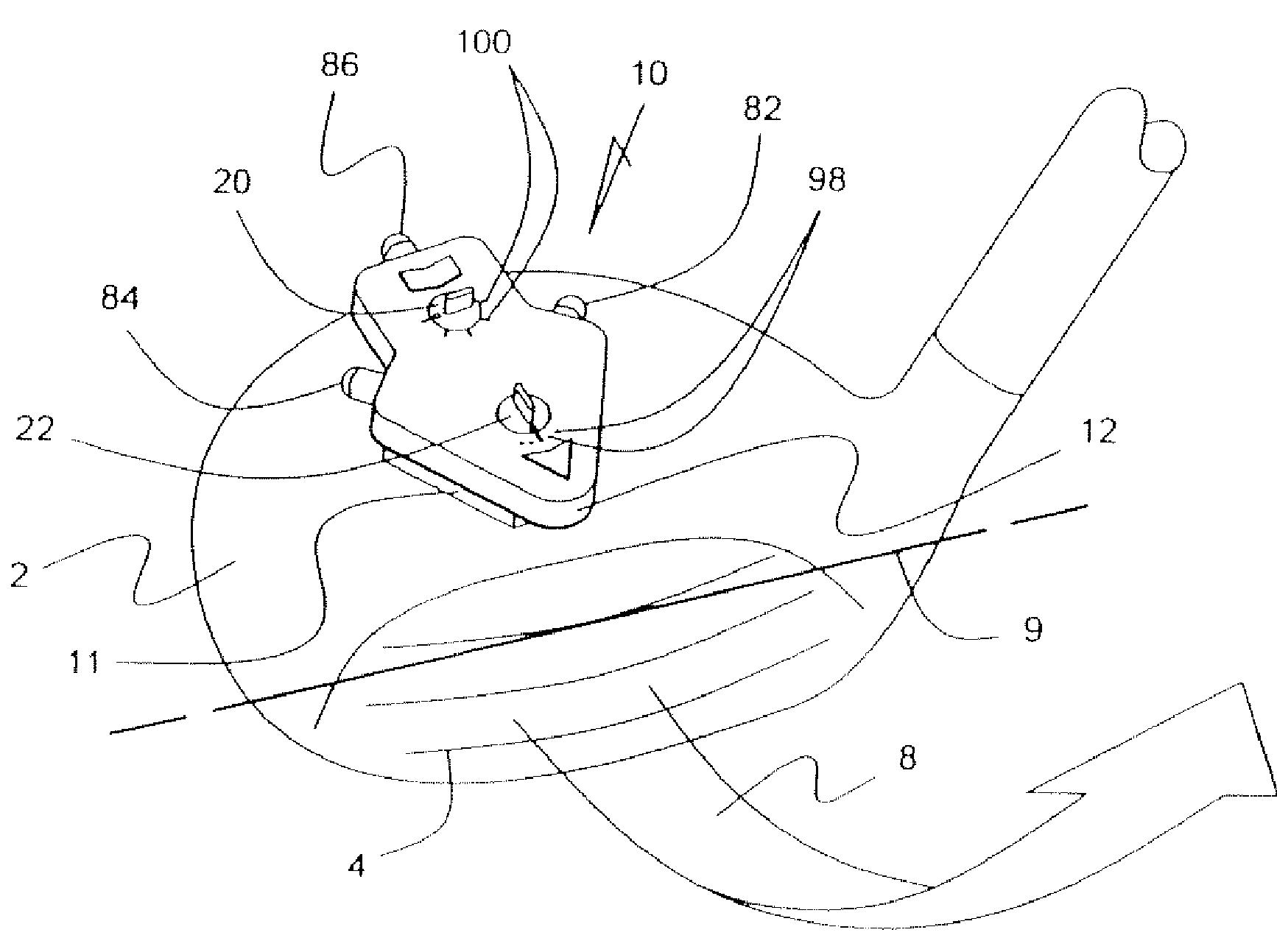If Priced Under $15, Sign Me Up!
Every now and then I come across a golf training invention disclosed in a patent application that makes me say “I would buy that (assuming it is priced right).” It happened last week when I came across the invention found in US Pub. No. 20090105004 titled “Inertially Responsive Golf Club Head Mounted Device for Instructing Correct Club Face Direction & Swing Speed.” Check out this nifty device.
The application explains:
[0010] The present invention teaches a device for a golf club for instructing club face orientation for a selected swing speed and in order to teach club head positioning and control for a selected swing tempo. The body housing has a selected thickness and such that a substantially pointed forward end thereof intersects a midpoint of the club contact face and in a perpendicularly extending direction relative to a coplanar axis extending across the club contact face. As will be described with reference to the several succeeding embodiments, the inertially responsive device is capable of being incorporated into any of a wood/driver, iron or putter variant.
[0011] In one variant, an adhesive tacky material applied to an underside surface of the body engages the body to a top surface of the club head. An on-board processor draws power from a portable power supply (e.g. lithium style 3 v battery) and is communicated with an inertially sensitive cam shaped member rotatably mounted within a location of the body.
[0012] Based upon a preferred variant of the design, either or both of swing/tempo speed and directional/target adjustment features are built into the body. A first variant incorporates both of these features and first includes a swing speed adjustment knob mounted in exposed fashion relative to an upper surface of the body and in contact with the inertially sensitive element via an adjustment spring. An audio-generating transistor and a plurality of LED elements cooperate can operate in a purely mechanical fashion according to one preferred embodiment or, in a desired variant, are communicable with the processor for instructing a correct planar orientation of a contacting face of the club head relative to the golf ball.
[0013] Additional features include a speed sensor contact post secured to an extending end of the adjustable spring, an opposite end of the spring fixedly securing at a forward location of the body and, depending upon forward or rearward adjustment of the post establishing a desired swing speed. An inner two piece frame is mounted within the housing, with first and second pairs of opposing frame ends communicating with opposite sides of a pair of speed sensor alignment studs with outer contact rings. A first and forward-most disposed of the frames is fixedly disposed within the body, the other and rearward disposed frame being linearly displaceable in response to rotation of the weighted and cam-shaped element.
[0014] A lithium style battery is mounted within the body, with a plurality of lead wires extending from the battery and connecting to first, second and third LED elements mounted to selected exterior locations of the body. The processor operates to instruct a selected LED element to illuminate, dependent upon at least one of a sensed club speed and an achieved planar orientation of the club face relative to the golf ball.
[0015] Additional features include a sound-generating transistor component is also mounted in the body and, in concurrent communication with the processor along with the LED) elements, issues a selected audio output to correspond with a selected illuminated LED). Yet additional features include an alignment adjustment dial (this consisting of a cooperating component in a primary dual functioning embodiment and an alternating secondary component) mounted in a forward spaced fashion relative to the speed sensor contact post, the adjustment dial exerting a selected sideways bias to the spring in order to compensate for left and right club face planar offset for a selected swing speed. The alignment adjustment dial further includes a pair of spaced apart posts extending in a direction opposite an exposed and user gripping portion, a selected one of the posts engaging a side location of the spring according to a given setting, and in order thereby to compensate for a user’s hook or slice tendencies by pre-stressing or pre-influencing the spring in a given lateral deflecting manner.
.
.
.
[0063] As will also be described in reference to the alternate variant of FIG. 4, a plurality of lead wires (not shown in FIGS. 3 and 8) extend from the battery 24 and connect to first 82, second 84 and third 86 LED elements mounted to selected exterior locations of the base 14 of the housing body. The processor instructs a selected LED element to illuminate, dependent upon at least one of a sensed club speed and an achieved planar orientation of the club face relative to the golf ball.[0064] As previously discussed, the sound-generating transistor component 26 is likewise mounted in said body and, in concurrent communication with said processor along with the LED elements 82, 84 and 86, issues a selected audio output to correspond with a selected illuminated LED. The selected LED instructs one of a “closed face/hook pull” (such as corresponding to a first colored, by example blue LED 82), an “open face/push slice” (second colored, by example yellow LED 84) and an “over set club head speed” (third colored, by example red LED 86). indication. Concurrently, the sound-generating transistor can cooperate with the selected LED to issue one of a “hook”, “nice shot” and “slice, fast swing” audio indication.
Pretty cool little device, but what would you pay for it? Fifteen bucks would be my limit.
Dave Dawsey – Tracking Golf Intellectual Property
PS – click HERE to check out interesting putter posts


